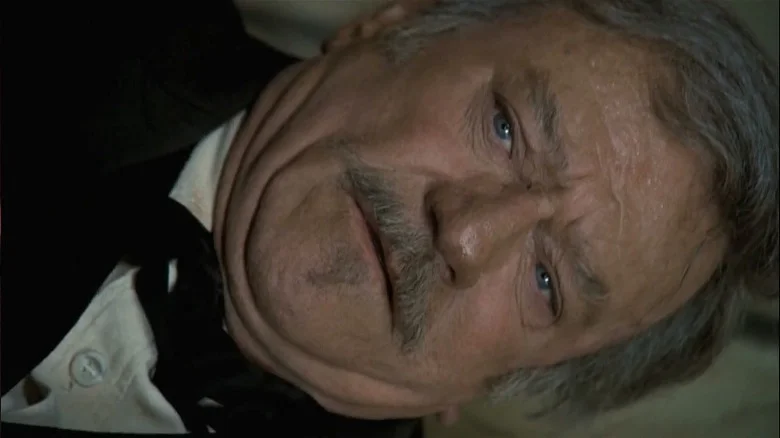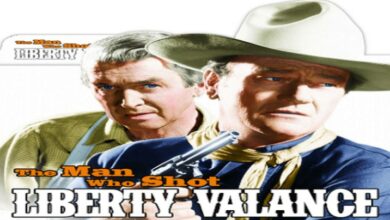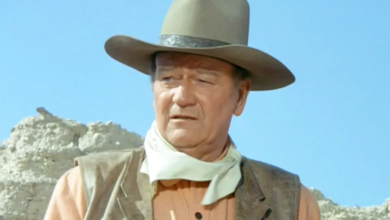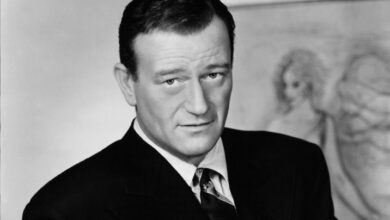The 27 Best John Wayne Films, Ranked – Part 2

15. The Searchers
Warner Bros.
I should get the other controversy out of the way. “The Searchers” is to John Ford what “Rio Bravo” is to Howard Hawks. It is a vaunted masterpiece that’s hailed by some as not only the best film of John Wayne’s career, but also the greatest example of the western genre (via AFI). Now, I like to go with the grain. I like to be engrossed by a film and connect with those who feel the same way, but “The Searchers” is another film that, while interesting, is less than the sum of its reputation.
Still, whatever you think of it, “The Searchers” is not just another mid-century western. The immediate distinction is Winton C. Hoch’s painterly cinematography; the image of Wayne framed by the cabin doorway is the definitive moment of the actor’s career. But what really elevates the film for many is the moral ambiguity of Ethan Edwards, John Wayne’s darkest character.
Prickly, spiteful, and bigoted, Edwards personifies the film’s vision of the frontier, a place where conflict is not a matter of good and evil but a painful cycle of death and enmity. However, the word “idea” is salient, for while “The Searchers” is dark in theme, it’s not dark in execution. It’s dated PG fare that’s toothless by comparison to “The Wild Bunch,” “Soldier Blue,” and numerous other revisionist westerns.
14. How the West Was Won
Warner Brothers/MGM
By the end of the 1950s, cinema was in trouble. Television had eroded the studios’ monopoly on visual entertainment and executives were scrambling to find an edge. Their solution was to tell big stories on a huge, sweeping scale, resulting in a wave of epics such as “Ben Hur,” “Spartacus,” and “How the West was Won,” the first narrative feature film to be presented on a curved Cinerama screen (via Britannica).
“How the West Was Won” followed a similar format to “The Longest Day,” released just under a month prior on October 4, 1962. Both films employed three directors, with “West” boasting the strongest line-up: John Ford, Henry Hathaway, and George Marshall. The national origin story is told in five chapters: “The Rivers,” “The Plains,” “The Civil War,” “The Railroad,” and “The Outlaws.” John Wayne appears as General William Tecumseh Sherman in the Civil War section, delivering another of his gruff military performances.
“How the West Was Won” is the proverbial ensemble epic, so Wayne isn’t afforded his usual star vehicle antics. However, the film is still an interesting piece of Hollywood mythmaking with gorgeous Technicolor visuals and a broadside of American A-list talent.
13. She Wore a Yellow Ribbon
RKO Radio Pictures
“She Wore a Yellow Ribbon” is a building block in the legacies of John Wayne and John Ford, mostly because of the scenery, which was captured on the Arizona-Utah border. It wasn’t the first time that Ford had shot a film in Monument Valley, but it was the first time that he took cinematographer Winton C. Hoch to the awesome sandstone buttes. Hoch captures the landscape’s sweeping vistas at all times of day, with the most arresting imagery coming at dusk, when the sky turns mauve and is streaked by an awesome yellow haze.
Hoch’s camerawork made a big impression on the western genre, but “Yellow Ribbon” was also a personal, important film for John Wayne. Like in “Red River” the year before, Wayne played a character some 20 years his senior, which required him to depict all the complexities and vulnerabilities that come with that. The Duke called his work as Captain Brittles “the best acting job I’ve done … It’s about the only picture I’ve been in where I could play a character that was a little apart from the image that has developed for me over the years on the screen” (via John Wayne: The Life and Legend).
12. Red River
United Artists
“Red River” is something of a watershed moment in Wayne’s career. The actor had spent the nine years since “Stagecoach,” his star-making film, building the robust but easygoing persona that he’d use for the rest of his career. However, the character of Thomas Dunson introduced viewers to a new, darker John Wayne performance.
Dunson isn’t an amiable gunslinger, but rather a rancher who manages his vast livestock with all the merciless ambition of John Dutton, the gruff patriarch of “Yellowstone.” Dunson lives with his herd near the Rio Grande, at the southern end of the Chisholm Trail. He figures that if he is to get the best price for his herd, he must lead a huge cattle drive along the trail to Missouri, no matter how arduous.
Numerous people suffer Dunson’s wrath on this journey, especially his adopted son, Matt (Montgomery Clift). It was the first time that Clift took his method acting from Broadway to the big screen, where it proved a sensitive counterweight to Wayne’s bullying antagonist (via TCM).
11. The Quiet Man
Republic Pictures
In “The Quiet Man,” John Wayne plays neither a cowboy nor a soldier. He instead appears as a retired boxer named Sean Thornton, who’s returning home from Pittsburgh to Inisfree on the rugged west coast of Ireland.
Set in the 1920s, the film depicts Ireland as a lush land of rolling hills, stone bridges, and cheerful locals — cheerful apart from Will Danaher (Victor McLaglen), that is. Danaher resents Sean’s intention to buy old Thornton land, but the real trouble arises when Sean falls for Danaher’s sister, Mary Kate (Maureen O’Hara).
“The Quiet Man” was the second of John Wayne’s films with Maureen O’Hara, a lifelong friend. Their chemistry is what makes “The Quiet Man” such an enduring classic, placing a weepy heart at the center of all the verdant beauty.
“Enduring” is not just an empty word; “The Quiet Man” made a lasting impact on the Irish village of Cong, where the film was shot. A lovely stone bridge that appears in the film is known today as “The Quiet Man Bridge,” and the village center has a statue and a museum dedicated to preserving the film’s memory (via Irish Post).
10. The Cowboys
United Archives/Getty Images
A highlight of Wayne’s later years, “The Cowboys” features the Duke at his most softly patriarchal. That’s because he’s responsible for leading a group of teenage boys along a 400 mile cattle drive. No sane man would choose such an endeavor, but it’s the only option available to Wil Andersen (Wayne), whose ranch hands have abandoned him for a gold rush.
The notion of “softly patriarchal” is subjective, of course. As viewers of “Hondo” will know, a John Wayne figure will gladly teach a boy to swim by throwing him into a pond. A similar moment occurs in “The Cowboys,” in which Andersen confronts a stuttering boy whose condition endangered a friend stranded in a river. Instead of consoling the child, Andersen accuses him of not trying hard enough to save his friend, which riles the boy to the point of repeatedly insulting Anderson, at which point the stutter stops. It’s an old school moment that a certain kind of father would nod at approvingly.
The nodding won’t last for long, though, because after much toil on the long and arduous cattle drive, “The Cowboys” ends in a divisively fatal fashion.
9. Stagecoach
United Artists
“Stagecoach” is usually cited as the beginning of John Wayne’s canon, but his first leading role was actually in “The Big Trail,” a pre-Code western from 1930. An ambitious and expensive production, “The Big Trail” bombed on release and put its 23-year-old star out to B-movie pasture for much of the decade (via TCM). Director John Ford helped cast Wayne in that doomed picture, and when the script for “Stagecoach” came together, he was adamant that John Wayne be given another chance. “He’ll be the biggest star ever,” Ford observed, “because he is the perfect everyman.”
Ford’s instincts were canny. “Stagecoach” brought Wayne to his biggest audience yet, showcasing the easy machismo he’d developed in the cinematic wilderness. The director also proved his own talents, capturing big characters and even bigger scenery in what became one of the most influential films of all time. Orson Welles said he watched the film 40 times in preparation for “Citizen Kane” (via Irish Film Institute).
8. Fort Apache
United Archives/Getty Images
John Wayne is usually the master of his domain; he calls the shots and controls the environment. However, that is not true of “Fort Apache,” the first film in John Ford’s “cavalry trilogy.” Here, Wayne plays Captain Kirby York, a civil war veteran who is strong, flexible, and yet subordinate to Lieutenant Colonel Owen Thursday (Henry Fonda), a patrician West Point graduate.
Thursday is chosen to lead the western outpost of Fort Apache, which is a job that requires tactful diplomacy with local Native Americans. However, the lieutenant colonel is ignorant of their customs and rejects any notion of co-operation. Instead, he rules the fort with dogmatic arrogance, leading the regiment into violent conflict with the Apache tribe. York butts heads with Thursday at every turn, but there is no overruling him. Thursday’s Custer syndrome can end only one way, and it isn’t pretty.
“Fort Apache” was novel for its time because it depicted Native Americans with nuance and empathy. We see the Apache not as villains but a community capable of reason and compromise, unlike Lieutenant Colonel Thursday.
7. The Longest Day
20th Century Fox
John Wayne is the first big actor to appear in “The Longest Day,” a sweeping account of the D-Day invasion. The film may have a bleak docudrama style with an ostensible focus on historical accuracy, but it doesn’t skimp on star power. The ensemble cast of “42 international stars” includes everyone from Richard Burton and Sean Connery to Robert Mitchum, Robert Ryan, and Henry Fonda.
Wayne drops his breezy charm to play Lieutenant Colonel Benjamin Vandervoort, delivering one of his more hard-edged performances. It’s an appropriate choice, given the subject matter, but Wayne was perhaps overly serious when it came to the Second World War. For instance, when Steven Spielberg sent Wayne the script for his war comedy “1941,” the aging star described it as “un-American” and telephoned the director to say, “Don’t joke about World War II” (via Contact Music).
There are few laughs in “The Longest Day.” The battle sequences may lack the bloody mayhem of “Saving Private Ryan,” but the film still captures the terrible waste of war. There’s no doubting the epic’s sheer scale, either. Hordes of actors and extras storm the screen, captured overhead by some of the finest aerial photography of the period.
6. El Dorado
United Archives/Getty Images
“El Dorado” is so similar to “Rio Bravo” that it’s effectively a remake. However, it is an exception to the rule that all remakes are inadequate by being superior in casting, combat, and story detail.
First, there’s the intriguing pairing of John Wayne and Robert Mitchum. They had both appeared in “The Longest Day,” but “El Dorado” was the only time the two Golden Era men shared the screen. Mitchum opens the film as Sheriff J.P. Harrah, who paces across the screen with a badge and broad shoulders. This doesn’t last, though. Harrah is the Dude character from “Rio Bravo,” so the demon liquor is waiting for him. Compared to Dean Martin, Mitchum is more anguished, although there is no rendition of “My Rifle, My Pony, and Me” here.
Washed up though he may be, Harrah has a job to do when gunslinger Cole Thornton (Wayne) returns to El Dorado. Together, they must protect an upstanding family against a greedy landowner with designs on their ranch and their water supply. Assisting them is Mississippi (James Caan), an incendiary young man who’s good with a knife but can’t shoot a bullet into the proverbial broad side of a barn.
I’m not sure why Howard Hawks made “El Dorado.” It is a rehash of a film that wasn’t even 10 years old. But I’m glad he did, because it makes up for a celebrated classic that left me cold.
5. Baby Face
Warner Brothers/YouTube
“Baby Face” is a timeless commentary on sexuality, ambition, and greed. It also features a terrific performance from Barbara Stanwyck, who avoids the stagey manner that dates even the best films of classic Hollywood.
Lily Powers is the titular “baby face,” which is a pet name given to her by Jimmy McCoy, played by a 25-year-old John Wayne. McCoy is Lily’s latest conquest and one of the more disposable ones, as he doesn’t have the means to support her grandiose ambitions in reaching all the avarice New York City has to offer.
Her quest begins in a ramshackle speakeasy in Erie, Pennsylvania. She sits idly in this industrial milieu, barked at by her abusive father, who “offers” her to a local politician to avoid getting busted by prohibition agents. Lily knows how to stand up for herself, but the young woman remains adrift until Adolf, an eccentric cobbler, introduces her to Nietzsche’s “will to power” philosophy. This awakens Lily’s sexuality, which becomes a tool of manipulation and then outright Machiavellianism, leaving a trail of wrecked marriages and broken hearts in its wake.
4. Hatari!
United Archives/Getty Images
“Rio Bravo” is the celebrated hang out film of John Wayne’s career, but who would want to hang out in the Old West? Me, actually. But first I’d visit the characters of “Hatari!” for drinks, dinner, and fun in 1960s Tanganyika (present day Tanzania).
Wayne stars as Sean Mercer, a tough but amiable outdoorsman who must lead a crew of big game catchers. His team includes Kurt (Hardy Krüger), a German race car driver; Pockets (Red Buttons), a sprightly New York cabbie; and Dallas (Elsa Martinelli), an Italian photographer. The characters share a whimsical chemistry as they joke, flirt, eat, and care for the compound’s exotic animals. You may not have seen “Hatari!,” but you’ll recognize Henry Mancini’s score during the cheeky elephant sequence, which typifies the film’s balmy escapism.
It’s not all R&R, though. The film is punctuated by a series of hunt scenes in which the actors use trucks, lassos, and cages to capture a range of wild animals including zebras, giraffes, leopards, buffalo, and even a rhinoceros. The methods seem antiquated by contemporary standards, but “Hatari!” is less questionable than other films from the period, like Jacques Cousteau’s documentary “The Silent World,” in which the famed oceanographer detonates reefs, slaughters sharks, and attacks sperm whales with the bow of his ship.
3. True Grit
Paramount Pictures
The film that won John Wayne the Oscar, “True Grit” is effectively a buddy film that pairs Rooster Cogburn (Wayne), a lumbering 6′ 4″ drunkard, with Mattie Ross (Kim Darby), a crusading teenager full of earnest resolve.
Their paths cross following the death of Mattie’s father, Frank (John Pickard), who’s shot dead by family acquaintance Tom Chaney (Jeff Corey). Dissatisfied by the sheriff’s inaction, Mattie meets with Cogburn because he is said to have “true grit,” which she believes to be a necessity for catching a villain like Chaney.
What follows is a power struggle between Mattie, Cogburn, and a Texas ranger named La Boeuf (Glen Campbell). This isn’t all conflict and survivalism, though. Mattie may be half an orphan, but “True Grit” is fairly light in tone. Its 128 minutes breeze by thanks to the leads’ charisma, the cat-and-mouse plotting, and the awesome Rocky Mountain adventurism. Glen Campbell’s single is a delight, too.
2. The Shootist
Paramount Pictures
The Duke’s last film is also one of his best. In “The Shootist,” Wayne plays J.B. Books, a gunfighter who, upon his arrival in Carson City, Nevada, is diagnosed with terminal cancer. The diagnosis is given by Dr. Hostetler (James Stewart), an old friend of Books who speaks frankly about the pain of Book’s condition and concludes one of their meetings with a bleak suggestion: “I would not die a death like I just described … not if I had your courage.”
J.B. Books breaks no new ground for Wayne, but he brings the best of his grit and chivalry to the role, and it works well against Bond Rogers (Lauren Bacall), a matronly boarding house owner who hosts Books with icy reluctance. However, it is real world circumstances that really gives “The Shootist” its poignant, funeral pathos.
In 1964, John Wayne was diagnosed with lung cancer. He would be given the all clear, but only after losing much of his left lung (via New York Times). Wayne kept busy through the 1960s and into the new decade, but ill health loomed over the actor’s psyche. “I have cancer,” Wayne told his son Patrick during a bout of stomach pain. “I’ve had cancer before and I know how it feels and I have it now.” In January 1979, the Duke was diagnosed with stomach cancer during gallbladder surgery. He died six months later.
1. The Man Who Shot Liberty Valance
Paramount/YouTube
Many point to “The Searchers” as the greatest collaboration between John Ford and John Wayne, but for me it’s “The Man Who Shot Liberty Valance,” a story of violence and justice on the American frontier.
All developed governments have a monopoly on violence. Citizens grant this monopoly in return for safety and security. But how often does this arrangement fail us? How often does it enable those who may do us harm? The residents of Shinbone ask these questions as the harbingers of progress reach their town in the early 20th century, the most notable of which is Ransom Stoddard (James Stewart), a high-minded senator who speaks stridently about the rule of law. His earnest rhetoric may work on Capitol Hill, but it doesn’t impress the people of Shinbone too much, especially Liberty Valance (Lee Marvin), the town’s worst outlaw.
Marvin is brilliant in the role. Far from being a cackling stock character, Liberty Valance is a thoroughly hateful man. If he’s not committing outright violence, he behaves like a playground bully. But Valance doesn’t have free rein in Shinbone; he’s stopped short by Tom Doniphon, performed by a career-best John Wayne.
Swaggering and violent but not unfair, Doniphon is precisely the figure you want in the absence of government authority. But is his violence preferable to Stoddard’s careerism and bureaucracy? At what point does the law stop and murky pragmatism begin? These are the compelling themes of this premier American western.
Read More: https://www.slashfilm.com/1184671/the-best-john-wayne-films-ranked/





